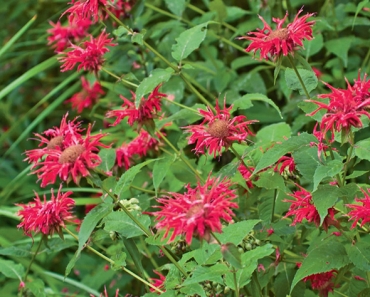Love it or loathe it, burdock is a plant that demands to be noticed. Native to Europe and Asia, this weedy biennial grows freely in temperate regions all over the world, bearing long leaves and thistlelike flowers that attract butterflies and bees. Its spiny seed heads are covered with stiff hooks that cling stubbornly to clothes and animals. These burrs are said to have inspired the Swiss inventor George de Mestral (1907–1990) to develop Velcro, which was patented in 1955. The plant’s common name comes from “bur,” for its tenacious burrs, and “dock,” an Old English word for plant.

Plant profile
Common Names: Burdock, Gobo, Greater Burdock
Description: Branched plants, 3 to 6 feet tall; crimson-purple, thistlelike flowers; large, alternate leaves have a heart-shaped base; spiny seed heads are covered with stiff hooks
Hardiness: To Zone 2
Family: Asteraceae
Flowering: Summer to fall
Parts Used: Root, seed heads, leaves, and young stalks
Range/Habitat: Native to Europe and Asia, naturalized worldwide; common in disturbed sites, such as ditches and roadsides
Culinary use
In Japan, burdock root is commonly eaten as a vegetable called gobo. The roots are slivered, soaked in water to remove their bitter flavor, and stir-fried with sesame oil and soy sauce. Found in sushi bars worldwide, burdock roots are also eaten raw in salads or cooked like carrots. In Scandinavian countries, the young spring leaves are eaten in salads.
To prepare burdock root, peel, chop, then soak the root for about 30 minutes in several changes of cold water. Try combining the prepared root with shredded carrot, minced fresh ginger, and lemon juice for an appetizer or salad. Young stalks can be peeled, chopped, and steamed, like asparagus.
Medicinal use
Burdock roots and seeds contain bitter glycosides, flavonoids, and tannins. In traditional Chinese medicine, burdock has long been considered an important blood purifier and is included in formulas designed to detoxify the liver and improve digestion. It’s also taken internally to treat inflammation. Native Americans used an infusion of the roots or seeds to cleanse blood and applied a poultice of the boiled leaves to sores.
Modern research indicates that burdock may have a liver-protective effect, as well as anti-inflammatory and antioxidant properties. It also contains a substance called arctigenin, which has shown antitumor effects in animal studies. Burdock is a mild antibacterial agent, making it useful in the treatment of skin conditions, including acne and boils, and as an ingredient in some shampoos, creams, and lotions.
How to grow it
Burdock thrives in full sun and fertile, moist, well-drained soil. Sow the seed directly in the garden when the temperature has warmed; thin seedlings to 6 inches apart. Some gardeners mix wood chips or sawdust into burdock beds to loosen the soil, making the 3-foot-long roots easier to harvest in fall or the following spring.



